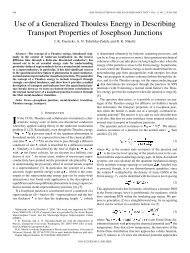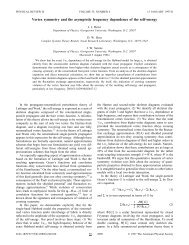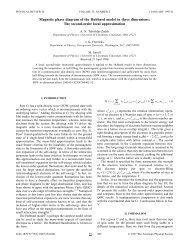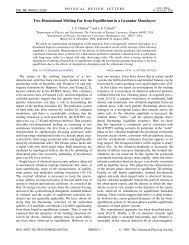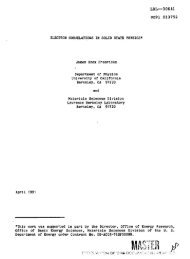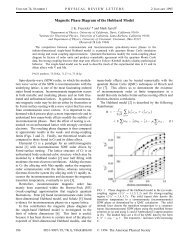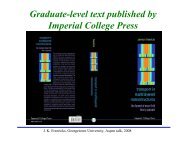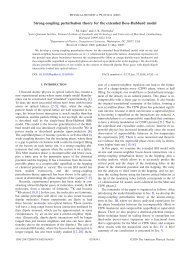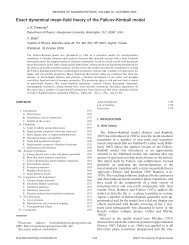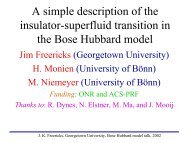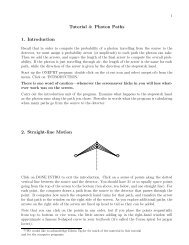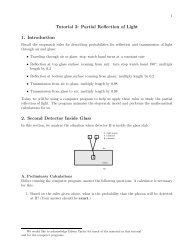Beyond Eliashberg superconductivity in MgB2 - Physics ...
Beyond Eliashberg superconductivity in MgB2 - Physics ...
Beyond Eliashberg superconductivity in MgB2 - Physics ...
You also want an ePaper? Increase the reach of your titles
YUMPU automatically turns print PDFs into web optimized ePapers that Google loves.
VOLUME 87, NUMBER 8 PHYSICAL REVIEW LETTERS 20AUGUST 2001<br />
<strong>Beyond</strong> <strong>Eliashberg</strong> Superconductivity <strong>in</strong> MgB 2 : Anharmonicity,<br />
Two-Phonon Scatter<strong>in</strong>g, and Multiple Gaps<br />
Amy Y. Liu, 1,2 I. I. Maz<strong>in</strong>, 2 and Jens Kortus 1,2,3<br />
1 Department of <strong>Physics</strong>, Georgetown University, Wash<strong>in</strong>gton, D.C. 20057<br />
2 Center for Computational Materials Science, Code 6390, Naval Research Laboratory, Wash<strong>in</strong>gton, D.C. 20375<br />
3 MPI für Festkörperforschung, Stuttgart, Germany<br />
(Received 27 March 2001; published 7 August 2001)<br />
Density-functional calculations of the phonon spectrum and electron-phonon coupl<strong>in</strong>g <strong>in</strong> MgB 2 are<br />
presented. The E 2g phonons, which <strong>in</strong>volve <strong>in</strong>-plane B displacements, couple strongly to the p x,y electronic<br />
bands. The isotropic electron-phonon coupl<strong>in</strong>g constant is calculated to be about 0.8. Allow<strong>in</strong>g<br />
for different order parameters <strong>in</strong> different bands, the superconduct<strong>in</strong>g l <strong>in</strong> the clean limit is calculated<br />
to be significantly larger. The E 2g phonons are strongly anharmonic, and the nonl<strong>in</strong>ear contribution to<br />
the coupl<strong>in</strong>g between the E 2g modes and the p x,y bands is significant.<br />
DOI: 10.1103/PhysRevLett.87.087005<br />
The recent discovery of <strong>superconductivity</strong> near 40 K<br />
<strong>in</strong> MgB 2 has generated much <strong>in</strong>terest <strong>in</strong> the properties<br />
of this simple <strong>in</strong>termetallic compound [1]. A significant<br />
B isotope effect strongly suggests phonon-mediated<br />
pair<strong>in</strong>g [2]. To expla<strong>in</strong> the large T c , an electron-phonon<br />
coupl<strong>in</strong>g (EPC) constant of l 1 is needed. Yet estimates<br />
of the coupl<strong>in</strong>g strength based on the latest measurements<br />
of the low-temperature specific heat [3], comb<strong>in</strong>ed<br />
with the density of states (DOS) from density-functional<br />
calculations [4], yield l 0.6 0.7. Further, the measured<br />
temperature dependence of the electrical resistivity<br />
[5] is consistent with l tr & 0.6. First-pr<strong>in</strong>ciples calculations<br />
of the EPC give l 0.7 0.9 [4,6,7]. Clearly there<br />
is a problem <strong>in</strong> reconcil<strong>in</strong>g all these numbers. Another<br />
puzzle <strong>in</strong>volves tunnel<strong>in</strong>g measurements of the gap. Values<br />
of 2Dk B T c rang<strong>in</strong>g from 1.2 to 4 have been reported.<br />
The values below the BCS weak-coupl<strong>in</strong>g limit of 3.5<br />
have been attributed to surface effects, but the best-quality<br />
spectra [8] show a very clean gap with 2Dk B T c 1.25.<br />
Sharv<strong>in</strong> contact measurements [9] reveal a gap at 4.3 meV<br />
2Dk B T c 2.6, and additional structures at 2Dk B T c <br />
1.5 and 3, rais<strong>in</strong>g the possibility of multiple gaps. Careful<br />
analysis of the temperature and magnetic-field dependence<br />
of the specific heat suggests anisotropic or multiple<br />
gap structure as well [3]. Thus, even if <strong>superconductivity</strong><br />
<strong>in</strong> MgB 2 is phonon-mediated, it is likely that an analysis<br />
beyond the simple isotropic <strong>Eliashberg</strong> model is needed.<br />
The MgB 2 lattice consists of two parallel systems of<br />
flat layers. One layer conta<strong>in</strong>s B atoms <strong>in</strong> a honeycomb<br />
lattice, the other Mg atoms <strong>in</strong> a triangular lattice halfway<br />
between the B layers. First-pr<strong>in</strong>ciples calculations [4] f<strong>in</strong>d<br />
that the electronic states near the Fermi level are primarily<br />
B <strong>in</strong> character and the Fermi surface (FS) comprises four<br />
sheets: two nearly cyl<strong>in</strong>drical hole sheets about the G-A<br />
l<strong>in</strong>e aris<strong>in</strong>g from quasi-2D p x,y B bands, and two tubular<br />
networks aris<strong>in</strong>g from 3D p z bond<strong>in</strong>g and antibond<strong>in</strong>g<br />
bands [4]. The difference <strong>in</strong> character between the<br />
sheets raises the possibility that each has a dist<strong>in</strong>ct gap that<br />
could be observed <strong>in</strong> the clean limit [10]. Such <strong>in</strong>terband<br />
PACS numbers: 74.25.Kc, 63.20.Ry, 74.25.Jb<br />
anisotropy enhances the effective EPC constant relevant to<br />
<strong>superconductivity</strong> and decreases the coupl<strong>in</strong>g constant for<br />
transport, compared to the average values [11–13]. This<br />
could expla<strong>in</strong> the discrepant values of l deduced from different<br />
types of experiments.<br />
In this Letter, we report first-pr<strong>in</strong>ciples calculations of<br />
the EPC <strong>in</strong> MgB 2 . The coupl<strong>in</strong>g constant is decomposed<br />
<strong>in</strong>to contributions from the four different bands cross<strong>in</strong>g<br />
the Fermi level, allow<strong>in</strong>g for an analysis of the effects<br />
of <strong>in</strong>terband anisotropy on the superconduct<strong>in</strong>g T c and<br />
gap structure. The strongest coupl<strong>in</strong>g arises from the E 2g<br />
phonon modes along the G to A l<strong>in</strong>e, which strongly <strong>in</strong>teract<br />
with the quasi-2D electronic states. This phonon mode<br />
is calculated to be highly anharmonic, and it also has significant<br />
nonl<strong>in</strong>ear contributions to the EPC [14].<br />
Harmonic phonon frequencies and l<strong>in</strong>ear EPC parameters<br />
were calculated us<strong>in</strong>g the l<strong>in</strong>ear-response method<br />
with<strong>in</strong> the local density approximation (LDA) [15]. Normconserv<strong>in</strong>g<br />
pseudopotentials [16] were used, with a<br />
plane-wave cutoff of 50 Ry. We used the experimental<br />
crystal structure, with a 3.08 Å and ca 1.14 [17].<br />
The electronic states were sampled on grids of up to<br />
24 3 k po<strong>in</strong>ts <strong>in</strong> the full Brillou<strong>in</strong> zone, and the dynamical<br />
matrix was calculated on a grid of 8 3 phonon wave<br />
vectors q [18].<br />
The calculated phonon density of states Fv and<br />
<strong>Eliashberg</strong> function a 2 Fv are plotted <strong>in</strong> Fig. 1. The<br />
results are similar to those reported <strong>in</strong> Refs. [6] and [7].<br />
All of these calculations give a slightly softer phonon<br />
spectrum than what is observed <strong>in</strong> neutron experiments<br />
[19]. While F and a 2 F are similar <strong>in</strong> shape <strong>in</strong> many<br />
materials, they are strik<strong>in</strong>gly different <strong>in</strong> MgB 2 . In<br />
particular, a 2 F has a pronounced peak <strong>in</strong> the range of<br />
60 to 70 meV aris<strong>in</strong>g from dispersive optic modes that<br />
do not give rise to large structures <strong>in</strong> F. Correspond<strong>in</strong>gly,<br />
the average phonon frequency v ave 55.3 meV<br />
is less than the logarithmically averaged frequency v ln <br />
expl R 21 lnva 2 Fvv 21 dv 56.2 meV, despite the<br />
fact that logarithmic averag<strong>in</strong>g preferentially weights<br />
087005-1 0031-90070187(8)087005(4)$15.00 © 2001 The American Physical Society 087005-1
VOLUME 87, NUMBER 8 PHYSICAL REVIEW LETTERS 20AUGUST 2001<br />
F (meV -1 )<br />
0.6<br />
0.3<br />
F<br />
α 2 F<br />
2<br />
1<br />
α 2 F<br />
with i 12 referr<strong>in</strong>g to the light(heavy)-hole 2D sheets<br />
of the Fermi surface, and i 34 to the p z bond<strong>in</strong>g<br />
(antibond<strong>in</strong>g) sheets. The EPC constant was also decomposed<br />
<strong>in</strong>to contributions from scatter<strong>in</strong>g of an electron<br />
from band i to band j:<br />
l 0 sc X ij<br />
U ij N i N j N X i<br />
l i N i N ,<br />
0<br />
0<br />
0 20 40 60 80 100<br />
ω (meV)<br />
FIG. 1.<br />
Phonon density of states and <strong>Eliashberg</strong> function.<br />
lower frequencies. The isotropic EPC constant, which determ<strong>in</strong>es<br />
T c <strong>in</strong> the dirty limit, l 0 sc 2 R v 21 a 2 Fv dv<br />
is found to be 0.77, <strong>in</strong> reasonable agreement with other<br />
calculations [4,6,7].<br />
The peak <strong>in</strong> a 2 F between 60 and 70 meV arises from<br />
the E 2g phonon modes with q along the G-A l<strong>in</strong>e. This<br />
Raman-active phonon mode, doubly degenerate at G, <strong>in</strong>volves<br />
<strong>in</strong>-plane, hexagon-distort<strong>in</strong>g displacements of the<br />
B atoms. In fact, by symmetry, this is the only mode at<br />
G that has a l<strong>in</strong>ear EPC. Go<strong>in</strong>g away from the G-A l<strong>in</strong>e<br />
the EPC drops sharply when the phonon wave vector q<br />
becomes larger than the diameter of the 2D Fermi surface;<br />
at the same time the frequency <strong>in</strong>creases by roughly<br />
30%. This <strong>in</strong>dicates that the reason why this B-B bondstretch<strong>in</strong>g<br />
mode is not the highest-frequency mode at G<br />
is because of soften<strong>in</strong>g due to EPC. However, this soften<strong>in</strong>g<br />
should weaken <strong>in</strong> the superconduct<strong>in</strong>g state, s<strong>in</strong>ce<br />
some of the screen<strong>in</strong>g electrons form Cooper pairs and are<br />
removed from the Fermi sea [20]. The overall scale of<br />
the relative harden<strong>in</strong>g, Dvv, is set by a specific EPC<br />
constant, l ZZ 2v P 21 ki jg k,k j 2 de ki , where g is the<br />
EPC matrix element. (The Fermi level is set to zero.) In<br />
the BCS limit, Dvv is a known analytical function [21]<br />
of v. We calculate l ZZ 0.6, for the E 2g mode. Tak<strong>in</strong>g<br />
D 5 meV we predict about a 12% harden<strong>in</strong>g of this<br />
mode below T c . This shift should be observable <strong>in</strong> Raman<br />
or neutron experiments.<br />
S<strong>in</strong>ce the 2D FSs are calculated to play an important role<br />
<strong>in</strong> the EPC, we have decomposed the relevant electronic<br />
characteristics <strong>in</strong> terms of the four sheets of the FS. We list<br />
<strong>in</strong> Table I the partial DOS N i P k de ki , and plasma<br />
frequencies<br />
v 2 p,i,aa 8pe2<br />
V<br />
W i 8pe2<br />
V<br />
P<br />
k y 2 ki,ade ki ,<br />
TABLE I. Band decomposition of the electronic density of<br />
states at the Fermi level and <strong>in</strong>-plane and out-of-plane plasma<br />
frequencies. The density of states is <strong>in</strong> units of states Ry 21<br />
sp<strong>in</strong> 21 cell 21 , and the plasma frequency is <strong>in</strong> eV.<br />
Total 1 2 3 4<br />
NE F 4.83 0.66 1.38 1.26 1.52<br />
v p,xx 7.21 2.91 2.95 3.05 5.04<br />
v p,zz 6.87 0.44 0.52 4.62 5.06<br />
U ij N i N j 2 X vqn 21 jgki,k1qjj n 2 de ki de k1qj .<br />
kqn<br />
Here v qn is the frequency of the correspond<strong>in</strong>g phonon,<br />
and lsc 0 is the standard (<strong>Eliashberg</strong>) isotropic coupl<strong>in</strong>g constant.<br />
Allow<strong>in</strong>g for <strong>in</strong>terband anisotropy of the order parameter<br />
(clean limit), the effective coupl<strong>in</strong>g constant for<br />
<strong>superconductivity</strong> lsc<br />
eff is given by the maximum eigenvalue<br />
of the matrix L ij U ij N i , which is always larger<br />
than l 0 sc . Assum<strong>in</strong>g the same <strong>in</strong>teraction parameters U ij<br />
for transport properties, the lowest order variational approximation<br />
for the Boltzmann equation corresponds to<br />
the transport EPC constant ltr 0 P i l i W i W . On the<br />
other hand, allow<strong>in</strong>g variational freedom for the different<br />
sheets of the Fermi surface yields an effective transport<br />
coupl<strong>in</strong>g constant which is always smaller than ltr 0 .<br />
In effect, the different bands provide parallel channels<br />
for conduction, so that when “scatter<strong>in</strong>g-<strong>in</strong>” is neglected,<br />
Wltr eff P i W i l i [13].<br />
The calculated <strong>in</strong>teraction parameters U ij are listed<br />
<strong>in</strong> Table II. Because of similarities between the two<br />
2D sheets, and between the two 3D sheets, we have<br />
simplified the model to allow for two different order<br />
parameters for these two sets of bands. This gives U AA <br />
0.47 Ry, U BB 0.10 Ry, and U AB 0.08 Ry, where<br />
A and B stand for the 2D and 3D bands, respectively.<br />
Then l A 1.19 and l B 0.45, suggest<strong>in</strong>g de Haas–<br />
van Alphen mass renormalizations of 2.2 and 1.5, for<br />
the two sets of bands, and specific-heat renormalization<br />
of 1.77 [22]. The result<strong>in</strong>g anisotropic effective coupl<strong>in</strong>g<br />
constant for <strong>superconductivity</strong> is lsc<br />
eff 1.01. Us<strong>in</strong>g the<br />
Allen-Dynes approximate formula for T c [23], we f<strong>in</strong>d<br />
that to have T c 40 K, a Coulomb pseudopotential of<br />
m 0.13 is needed. This is a more conventional value<br />
than the m 0.04 required when lsc 0 is used. For transport,<br />
<strong>in</strong>terband anisotropy reduces the <strong>in</strong>-plane coupl<strong>in</strong>g<br />
constant l x,y from 0.70 to 0.58, but has essentially no<br />
effect on the out-of-plane l z 0.46 (Table III). This<br />
is because the anisotropic formula accounts for the fact<br />
TABLE II. Band decomposition of the electron-phonon<br />
<strong>in</strong>teraction.<br />
ij 11 12 13 14 22<br />
U ij (Ry) 0.676 0.419 0.064 0.096 0.477<br />
ij 23 24 33 34 44<br />
U ij (Ry) 0.064 0.097 0.113 0.106 0.092<br />
087005-2 087005-2
VOLUME 87, NUMBER 8 PHYSICAL REVIEW LETTERS 20AUGUST 2001<br />
TABLE III. Calculated superconduct<strong>in</strong>g and transport<br />
electron-phonon coupl<strong>in</strong>g parameters <strong>in</strong> both the isotropic limit<br />
and with <strong>in</strong>terband anisotropy. The last column conta<strong>in</strong>s an<br />
average l tr appropriate for polycrystall<strong>in</strong>e samples.<br />
l sc l tr,x l tr,z l tr,ave<br />
Isotropic 0.77 0.70 0.46 0.60<br />
Multigap 1.01 0.58 0.46 0.54<br />
that the transport is mostly due to the 3D bands <strong>in</strong> any<br />
direction, simply because they couple less with phonons.<br />
The measured resistivity [5] can be fit remarkably well<br />
with the Bloch-Grüneisen formula us<strong>in</strong>g the calculated<br />
isotropic atr 2 F, with the <strong>in</strong>-plane and out-of-plane contributions<br />
appropriately averaged for polycrystall<strong>in</strong>e samples<br />
[24]. With band anisotropy, the resistivity is slightly<br />
underestimated.<br />
The temperature dependence of the <strong>in</strong>dividual gaps D i<br />
<strong>in</strong> the weak-coupl<strong>in</strong>g multigap model is def<strong>in</strong>ed by D i <br />
R q<br />
q<br />
Pj U ij N j D j dE tanh E 2 1Dj2T<br />
2 E 2 1Dj.<br />
2 As<br />
shown <strong>in</strong> Fig. 2, the larger 2D gap is calculated to be BCSlike,<br />
with a slightly enhanced 2DT c , while the 3D gap is<br />
about 3 times smaller <strong>in</strong> magnitude. Thus, <strong>in</strong> the clean<br />
limit, MgB 2 should have two very different order parameters,<br />
which <strong>in</strong> turn should affect thermodynamic properties<br />
<strong>in</strong> the superconduct<strong>in</strong>g state. Experiments <strong>in</strong>dicate that the<br />
coherence length <strong>in</strong> MgB 2 is close to 50 Å. The mean free<br />
path correspond<strong>in</strong>g to the residual resistivity observed <strong>in</strong><br />
Ref. [5] is more than 1000 Å, so that 2pjl 13. This<br />
is <strong>in</strong> the reasonably clean regime, and it is likely that the<br />
<strong>in</strong>tr<strong>in</strong>sic resistivity is even smaller. However, stronger defect<br />
scatter<strong>in</strong>g should be detrimental to <strong>superconductivity</strong>:<br />
us<strong>in</strong>g the Allen-Dynes formula with the same m 0.13,<br />
we get an isotropic T c 22 K. Indeed, irradiation has<br />
been found to drastically reduce T c [25]. Some of the<br />
experimental manifestations of multigap <strong>superconductivity</strong><br />
would be a reduced and impurity-sensitive specific-heat<br />
jump at T c , a deviation of the critical-field temperature<br />
∆/ωD<br />
1<br />
0.8<br />
0.6<br />
0.4<br />
0.2<br />
0<br />
0 0.1 0.2 0.3 0.4 0.5<br />
T/ω D<br />
FIG. 2. Ratio of superconduct<strong>in</strong>g order parameters D i to<br />
Debye frequency v D <strong>in</strong> the multigap weak-coupl<strong>in</strong>g approximation<br />
(solid l<strong>in</strong>es), and <strong>in</strong> the isotropic (dirty) BCS limit (th<strong>in</strong><br />
l<strong>in</strong>e). The BCS order parameter correspond<strong>in</strong>g to the same T c<br />
as the multigap model is shown by the dashed l<strong>in</strong>e.<br />
dependence from the Hohenberg-Werthamer formula, a reduction<br />
of the Hebel-Slichter peak <strong>in</strong> NMR, and a substantial<br />
difference between the <strong>in</strong>-plane and out-of-plane<br />
tunnel<strong>in</strong>g spectra. In particular, the latter should see only<br />
the smaller gap [26].<br />
Note that l 1 is <strong>in</strong> the <strong>in</strong>termediate-coupl<strong>in</strong>g regime.<br />
Furthermore, the multigap scenario suggests particular<br />
sensitivity to impurity scatter<strong>in</strong>g. This means one should<br />
really solve the anisotropic <strong>Eliashberg</strong> equations with<br />
impurity scatter<strong>in</strong>g, rather than the weak-coupl<strong>in</strong>g BCS<br />
equations we used. Thus we do not make any quantitative<br />
thermodynamic and spectroscopic predictions here.<br />
We focus now on the E 2g phonon modes, which<br />
contribute strongly to the EPC. We have exam<strong>in</strong>ed this<br />
mode at G <strong>in</strong> detail with frozen-phonon calculations us<strong>in</strong>g<br />
a general-potential l<strong>in</strong>earized augmented plane wave code<br />
as <strong>in</strong> Ref. [4]. This mode has substantial anharmonicity.<br />
A fit of the total energy for B displacements u between<br />
60.1 a.u. to a fourth-order polynomial E tot P a n u n <br />
gives a 2 0.42 Rya.u. 2 , a 3 20.66 Rya.u. 3 , and<br />
a 4 3.73 Rya.u. 4 for displacements parallel to one set<br />
of B-B bonds. For the other E 2g displacement pattern (i.e.,<br />
perpendicular to B-B bonds), we obta<strong>in</strong> the same values<br />
for a 2 and a 4 ,buta 3 0 by symmetry. Anharmonicity<br />
<strong>in</strong>creases the E 2g frequency by about 15%, which should<br />
result <strong>in</strong> an overall reduction of l by 10%, and an<br />
<strong>in</strong>crease of v ln by 6%.<br />
More <strong>in</strong>terest<strong>in</strong>gly, the E 2g modes have a significant<br />
nonl<strong>in</strong>ear coupl<strong>in</strong>g with electrons. The l<strong>in</strong>ear coupl<strong>in</strong>g<br />
vertex, g 1 , correspond<strong>in</strong>g to scatter<strong>in</strong>g by a s<strong>in</strong>gle phonon,<br />
is proportional to matrix elements of dVdQ, where<br />
Q p 2Mv u, while the second-order coupl<strong>in</strong>g, <strong>in</strong>volv<strong>in</strong>g<br />
exchange of two phonons, is proportional to matrix<br />
elements of d 2 VdQ 2 .AtG, the Hellman-Feynman theorem<br />
allows the calculation of g 1 via deformation potentials.<br />
This is no longer the case for g 2 . One can use d 2 e k dQ 2<br />
only as a qualitative estimate of d 2 VdQ 2 . For the cyl<strong>in</strong>drical<br />
sheets of the Fermi surface, with B displacements<br />
parallel to bonds, d 2 e k dQ 2 2 12 72 and 40 mRy<br />
as compared to de k dQ 2 12 20 and 20 mRy. This<br />
suggests that nonl<strong>in</strong>ear pair<strong>in</strong>g via two-phonon exchange<br />
is comparable to or even larger than the l<strong>in</strong>ear coupl<strong>in</strong>g.<br />
The reason for this anomalous behavior lies <strong>in</strong> the<br />
specifics of the band structure of the 2D p x,y bands. In the<br />
nearest-neighbor tight-b<strong>in</strong>d<strong>in</strong>g approximation it can be<br />
described as<br />
e 2 k u k 6y k ,<br />
4u k t 2 p 1 t2 s µ<br />
6 1 X i<br />
4y k 2 4t 2 p 2 t2 s 2 µ X<br />
i<br />
1 3t p 2 t s 4 µ X<br />
i<br />
∂<br />
X<br />
cosG i 1 6t p t s cosG i ,<br />
cos 2 G i 2 X ∂<br />
cosG i cosG j<br />
ifij<br />
s<strong>in</strong>G i<br />
∂ 2<br />
,<br />
i<br />
087005-3 087005-3
VOLUME 87, NUMBER 8 PHYSICAL REVIEW LETTERS 20AUGUST 2001<br />
FIG. 3. Fermi surfaces for two frozen-phonon patterns of E 2g<br />
symmetry with B displacements of 60.07 a.u.<br />
is needed to better elucidate the effect of anharmonicity<br />
and nonl<strong>in</strong>ear coupl<strong>in</strong>g on the superconduct<strong>in</strong>g properties<br />
of this material.<br />
We thank J. K. Freericks for helpful discussions. This<br />
work was supported by NSF under Grant No. DMR-<br />
9973225 and by ONR. A. Y. L. acknowledges support<br />
from the ASEE-U.S. Navy Faculty Sabbatical Program.<br />
where G i a i k, and a i are the three smallest lattice vectors.<br />
At the G po<strong>in</strong>t y k 0, and there are two doubly<br />
degenerate states. The bond<strong>in</strong>g pair forms the 2D Fermi<br />
surfaces, and the ma<strong>in</strong> effect of the E 2g phonons is to lift<br />
the degeneracy at G, thereby chang<strong>in</strong>g the overall splitt<strong>in</strong>g<br />
between the two subbands. This effect does not depend on<br />
the sign of the ionic displacement (the degeneracy is lifted<br />
either way) and thus is nonl<strong>in</strong>ear by def<strong>in</strong>ition. This is<br />
illustrated <strong>in</strong> Fig. 3 by the Fermi-surface plots for two opposite<br />
E 2g phonon patterns, both correspond<strong>in</strong>g to Q 1.<br />
One can see that while for the 3D sheets the coupl<strong>in</strong>g is<br />
mostly l<strong>in</strong>ear (changes of the Fermi surface are opposite),<br />
for the 2D cyl<strong>in</strong>ders it is mostly quadratic (changes are<br />
the same; cf. the undistorted Fermi surface <strong>in</strong> Ref. [4]).<br />
Nonl<strong>in</strong>ear EPC is also a likely source of anharmonicity:<br />
as discussed above, the contribution to the E 2g phonon<br />
self-energy from the EPC with the 2D FSs amounts to as<br />
much as 20 meV, as evidenced by the soften<strong>in</strong>g of this<br />
phonon at G. A sizable part of this soften<strong>in</strong>g probably<br />
comes from two-phonon processes. Quartic anharmonicity<br />
of the ion-ion <strong>in</strong>teraction arises <strong>in</strong> the fourth order <strong>in</strong><br />
the l<strong>in</strong>ear <strong>in</strong>teraction constant, but <strong>in</strong> the second order <strong>in</strong><br />
the nonl<strong>in</strong>ear one.<br />
In summary, we have presented a first-pr<strong>in</strong>ciples <strong>in</strong>vestigation<br />
of the electron-phonon coupl<strong>in</strong>g <strong>in</strong> MgB 2 . Interband<br />
anisotropy enhances the coupl<strong>in</strong>g constant from its<br />
isotropic dirty-limit value of l 0 sc 0.77 to an effective<br />
clean-limit value of lsc<br />
eff 1.01 for <strong>superconductivity</strong>.<br />
With v ln 56.2 meV, this lsc<br />
eff is arguably consistent<br />
with the measured T c of nearly 40 K. In the clean limit,<br />
we predict two different superconduct<strong>in</strong>g order parameters:<br />
a larger one on the 2D FSs and a smaller one (by<br />
approximately one-third) on the 3D FSs. S<strong>in</strong>ce current<br />
experiments suggest that MgB 2 is <strong>in</strong>deed <strong>in</strong> the clean<br />
limit, multiple gaps should be observable. There are h<strong>in</strong>ts<br />
of this <strong>in</strong> both the tunnel<strong>in</strong>g and thermodynamic data.<br />
The E 2g phonon mode <strong>in</strong>volv<strong>in</strong>g <strong>in</strong>-plane B motion provides<br />
the strongest coupl<strong>in</strong>g. We predict a harden<strong>in</strong>g of<br />
12% of this mode at the zone center below T c . In addition,<br />
this mode is highly anharmonic, and it may also<br />
have significant two-phonon coupl<strong>in</strong>g. The former likely<br />
reduces the l<strong>in</strong>ear EPC, while the latter <strong>in</strong>creases the total<br />
EPC. Both effects may contribute to the significant deviation<br />
of the total isotope coefficient from 0.5. Further work<br />
[1] J. Nagamatsu et al., Nature (London) 410, 63 (2001).<br />
[2] S. L. Bud’ko et al., Phys. Rev. Lett. 86, 1877 (2001).<br />
[3] Y. Wang et al., Physica (Amsterdam) 355C, 179 (2001);<br />
F. Bouquet et al., Phys. Rev. Lett. 87, 047001 (2001).<br />
[4] J. Kortus et al., Phys. Rev. Lett. 86, 4656 (2001).<br />
[5] P. Canfield et al., Phys. Rev. Lett. 86, 2423 (2001).<br />
[6] Y. Kong et al., Phys. Rev. B 64, 020501 (2001).<br />
[7] K.-P. Bohnen, R. Heid, and B. Renker, Phys. Rev. Lett. 86,<br />
5771 (2001).<br />
[8] G. Rubio-Boll<strong>in</strong>ger, H. Suderow, and S. Vieira, Phys. Rev.<br />
Lett. 86, 5582 (2001).<br />
[9] H. Schmidt et al., Phys. Rev. B 63, 220504 (2001).<br />
[10] S. V. Shulga et al., cond-mat/0103154.<br />
[11] H. Suhl, B. T. Matthias, and L. R. Walker, Phys. Rev. Lett.<br />
3, 552 (1959).<br />
[12] W. H. Butler and P. B. Allen, <strong>in</strong> Superconductivity <strong>in</strong> d-<br />
and f-band Metals, edited by D. H. Douglass (Plenum, New<br />
York, 1976).<br />
[13] I. I. Maz<strong>in</strong> et al., Physica (Amsterdam) 209C, 125 (1993).<br />
[14] T. Yildirim et al., cond-mat/0103469.<br />
[15] A. A. Quong and B. M. Kle<strong>in</strong>, Phys. Rev. B 46, 10 734<br />
(1992); A. Y. Liu and A. A. Quong, ibid. 53, 7575 (1996).<br />
[16] N. Troullier and J. L. Mart<strong>in</strong>s, Phys. Rev. B 43, 8861<br />
(1991).<br />
[17] E. L. Muetterties, The Chemistry of Boron and Its Compounds<br />
(Wiley, New York, 1967).<br />
[18] Neglect<strong>in</strong>g <strong>in</strong>terband scatter<strong>in</strong>g, it is not possible for an<br />
optic mode at q 0 to couple to electrons s<strong>in</strong>ce energy<br />
cannot be conserved. The contribution to the EPC from the<br />
region near G is estimated by assum<strong>in</strong>g a constant matrix<br />
element <strong>in</strong> this region and approximat<strong>in</strong>g the Fermi surface<br />
as two cyl<strong>in</strong>drical sheets [21].<br />
[19] R. Osborn et al., Phys. Rev. Lett. 87, 017005 (2001).<br />
[20] R. Zeyher and G. Zwicknagl, Solid State Commun. 66, 617<br />
(1988); Z. Phys. B 78, 175 (1990).<br />
[21] C. O. Rodriguez et al., Phys. Rev. B 42, 2692 (1990).<br />
[22] Current experiments [3] <strong>in</strong>dicate renormalization of 1.6, but<br />
the LDA may overestimate the DOS by 10% 15%. The<br />
overestimation of NMR relaxation rates by the LDA provides<br />
<strong>in</strong>direct evidence of this [E. Pavar<strong>in</strong>i (unpublished)].<br />
[23] P. B. Allen and R. C. Dynes, Phys. Rev. B 12, 905 (1975).<br />
[24] D. Stroud, Phys. Rev. B 12, 3368 (1975).<br />
[25] A. E. Kark<strong>in</strong> et al., cond-mat/0103344.<br />
[26] In Ref. [8], where high-quality spectra with a gap 3 times<br />
smaller than the BCS value were obta<strong>in</strong>ed, a unique procedure<br />
was used for sample preparation, which may have<br />
preferentially oriented <strong>in</strong>dividual microcrystals.<br />
087005-4 087005-4




